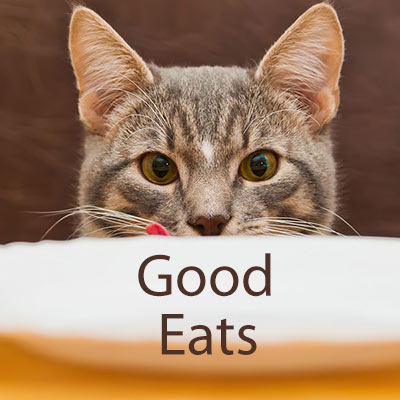Cat Feeding Basics
In their natural environment, cats are obligate carnivores, meaning that their nutritional requirements are met by eating a diet that consists of animal-based proteins (eg. mice, birds). The history of the cat indicates that the cat has eaten a purely carnivorous diet throughout its entire development. Feeding behaviors that have evolved to fit this lifestyle include searching, hunting and catching prey as well as postprandial behaviors such as grooming and sleeping. Daily energy requirements of average middle aged adult cats is generally between 60-80 kcal/kg body wt/day. Caloric requirements for neutered or inactive cats are toward the lower end of the range and may be as low as 50kcal/kg of body wt. For the average cat, the range would be 20-25 kcal/lb/day.
There are lots of choices of cat foods. What should I feed my kitten?
Diet is extremely important in the growing months of a cat’s life, and there are two important criteria that should be met in selecting food for your kitten. We recommend a NAME-BRAND FOOD made by a national cat food company (not a generic or local brand), and a form of food MADE FOR KITTENS. This should be fed until your kitten is about 8-12 months of age before switching to a diet made for adult cats. We recommend that you only buy food that has the AAFCO certification and that has been proven by feeding trials to be nutritionally complete; that is, when cats are fed these higher quality diets as the sole diet without any added food or supplement of any type, the diet meets or exceeds the requirements or is nutritionally adequate for all stages of the life cycle. There is no adverse effect from feeding these diets. Usually you can find the AAFCO certification and the food trial information very easily on the label. AAFCO is an organization that oversees the entire pet food industry. It does not endorse any particular food, but it will certify that the food has met the minimum requirements for nutrition.
Most of the commercial pet foods will have the AAFCO label. Generic brands often do not have it.
Should I Feed My Cat Dry or Wet Food?
Feeding a dry or canned form of cat food is acceptable. Each has advantages and disadvantages. Dry food is definitely the most inexpensive. However, canned food is high in protein and low in carbohydrates and may be preferred for those cats that are overweight. In addition, meal feeding twice daily is recommended for better weight management. “Free-choice” feeding often leads to an overweight cat.
How Can I Get My Cat To Lose Weight?
Obesity is the number one nutritional problem in cats and can lead to numerous health issues including diabetes mellitus, heart disease and orthopedic problems. However, a measured amount can be left in the cat’s bowl for the entire day as long as you remove the remaining food before feeding your cat for the next day; do not “top” off the bowl with more food. If given the choice, the average cat will eat a mouthful of food about 12-20 times per day.
Can I Feed My Cat Table Scraps?
It is estimated that 40-60% of cats are regularly fed table foods. Table foods are not recommended. Because they are generally very tasty, cats will often begin to hold out for these and not eat their well-balanced cat food. Providing such treats is unnecessary and may negatively affect a well-balanced diet when fed in excess. Do not feel guilty if your cat is happy to just eat one food day after day, week after week.
How To Select The Right Food for My Cat
Commercials for cat food can be very misleading. If you watch carefully, you will notice that commercials promote cat food on one basis: TASTE. Nutrition is rarely mentioned. Most of the “gourmet” foods are marketed to appeal to owners who want the best for their cats; however, they do not offer the cat any nutritional advantage over a good quality dry food, and they are far more expensive. If your cat eats a gourmet food very long, it will probably not be happy with other foods. If it needs a special diet due to a health problem later in life, it is very unlikely to accept it. Therefore, we do not encourage feeding gourmet cat foods.
Don’t Feed Cats Dog Food
Feeding dog foods to cats is one of the most common feeding errors. CATS ARE NOT SMALL DOGS! Most dog foods do not meet feline requirements, and as a result, will cause a number of nutritional problems in the cat. The cat’s nutritional requirements are quite different than that of a dog’s.
These differences are primarily because the cat is a true carnivore; whereas, the dog, like the pig or man, is an omnivore nutritionally. Problems in the cat resulting from these differences can be corrected by feeding diets consisting of more animal and less plant source foods.
What to Feed a Kitten
When feeding your kitten, you should keep these factors in mind: Respect your kitten’s privacy. Don’t disturb her while she’s eating. Food and water bowls should be placed in quiet out-of–the-way places.
- Be sure your kitten has fresh water at all times, especially during warmer weather.
- Place your kitten’s water dish at least 6 inches away from its food. That way she won’t associate water only with eating.
- Use a bowl that your kitten cannot tip over easily. Clean her food and water dishes as needed or at least once a week.
- Be flexible. Feeding instructions are only guidelines. Based on the body condition of the cat, adjust the amount as needed. The amount of food your kitten needs will vary with age, weight, breed, temperament, environment and activity level.
- If you choose a dry food, you can leave a measured quantity for the day in your kitten’s dish and let her choose her own meal times. Cats seldom overeat unless they are routinely tempted with large amounts of food.
- Although some owners choose to supplement commercial cat foods with milk, this should never be necessary if the commercial food is nutritionally balanced and complete. Moreover a large number of cats cannot properly digest the lactose in milk and may develop gas or diarrhea.
- Feed kitten food until 1 year of age, then you should switch to an adult food.

